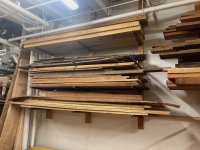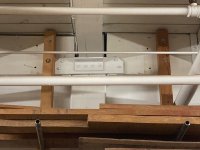richard newman
Titanium
- Joined
- Jul 28, 2006
- Location
- rochester, ny
I'm wondering what kind of anchors or shields are best to use in cinder block and brick walls? Moving into a new shop & want to hang cantilevered racks as in the photo. I've always been in old mill buildings with huge wooden beams, just used a couple of 1/2" lag bolts at the top of the 4x4's. New building has steel roof trusses which can't bear much weight, so I need to lag into the walls. Will probably extend the 4x4's them down to the floor to support the weight, just need to be sure the bolts won't pull out and allow the rack to topple. Probably a lot less than 500 lbs per 4x4.
Is it best to drill into morter joints or into the blocks or bricks themselves?
Is it best to drill into morter joints or into the blocks or bricks themselves?






